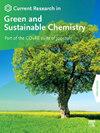Enhancing sustainable silk Textiles: Optimization of teak leaf extract dyeing and antibacterial efficacy
Q2 Materials Science
Current Research in Green and Sustainable Chemistry
Pub Date : 2025-01-01
DOI:10.1016/j.crgsc.2025.100457
引用次数: 0
Abstract
This study introduces an environmentally friendly method for dyeing silk using pigments extracted from young teak leaves (Tectona grandis L.), offering a sustainable solution to reduce pollution from synthetic dyes while repurposing agricultural waste. Ethanol (95 %) extraction of teak leaves showed a rich in polyphenols and quinonoid compounds, which yielded a reddish-brown pigment suitable for dyeing. Key dyeing conditions, including temperature (30–100 °C), duration (10–60 min), and pH (3–11), were optimized to maximize color absorption and uniformity. Color performance was evaluated through spectrophotometry (L∗, a∗, b∗ values) and K/S measurements. Three mordants including alum (aluminum potassium sulfate), ferrous sulfate, and stannous chloride were tested using pre-, meta-, and post-mordanting techniques. Pre-mordanting with ferrous sulfate delivered the darkest shades and highest color intensity, along with excellent wash and light fastness (rated ≥4 on the Grey scale). FTIR spectroscopy revealed stable dye-mordant complexes formed through molecular coordination. The dyed silk exhibited mild antibacterial properties against Staphylococcus aureus and Escherichia coli in agar well diffusion tests, though inhibition zones were modest (<0.20 cm), likely due to residual bioactive compounds. These results position teak leaf extract as a multifunctional natural dye, combining aesthetic, ecological, and hygienic advantages. By aligning with circular economy principles, this approach presents a viable pathway for sustainable textile production. Nonetheless, future research should focus on optimizing extraction methods, boosting antimicrobial efficacy, and scaling the process for industrial applications.

增强丝绸纺织品的可持续性:柚木叶提取物染色和抗菌效果的优化
本研究介绍了一种从柚木幼叶(Tectona grandis L.)中提取的色素染色丝绸的环保方法,提供了一种可持续的解决方案,以减少合成染料的污染,同时重新利用农业废弃物。乙醇(95%)提取的柚木叶中含有丰富的多酚类和类醌类化合物,可制得适合染色的红褐色色素。优化了染色温度(30-100℃)、持续时间(10-60 min)和pH(3-11)等关键染色条件,以最大限度地提高颜色吸收和均匀性。通过分光光度法(L∗,a∗,b∗值)和K/S测量评估显色性能。三种媒染剂,包括明矾(硫酸铝钾),硫酸亚铁和氯化亚锡进行了测试,使用前,中,后媒染剂技术。用硫酸亚铁预涂布可获得最深的色调和最高的色强,以及出色的耐洗和耐光性(灰色等级≥4)。红外光谱显示通过分子配位形成稳定的染料媒染剂配合物。在琼脂孔扩散试验中,染色蚕丝对金黄色葡萄球菌和大肠杆菌表现出温和的抗菌性能,尽管抑制范围不大(0.20 cm),可能是由于残留的生物活性化合物。这些结果将柚木叶提取物定位为一种集美观、生态和卫生优点于一体的多功能天然染料。通过与循环经济原则相一致,这种方法为可持续纺织品生产提供了一条可行的途径。尽管如此,未来的研究应侧重于优化提取方法,提高抗菌功效,并扩大工业应用的过程。
本文章由计算机程序翻译,如有差异,请以英文原文为准。
求助全文
约1分钟内获得全文
求助全文
来源期刊

Current Research in Green and Sustainable Chemistry
Materials Science-Materials Chemistry
CiteScore
11.20
自引率
0.00%
发文量
116
审稿时长
78 days
 求助内容:
求助内容: 应助结果提醒方式:
应助结果提醒方式:


